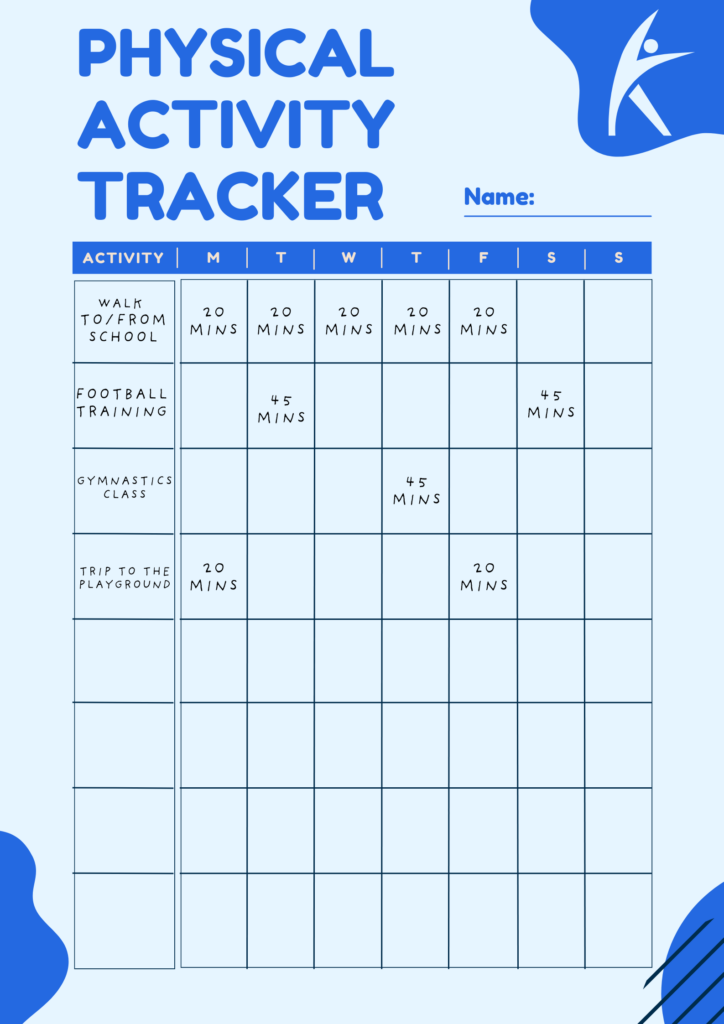Summer holidays are here! While kids are thrilled with the break from school, the change in routine can often lead to a big drop in how much they move. Without their usual PE lessons, yard time, or after-school sports, many children end up spending more time sitting still than running around.
And research backs this up. A recent study from the University of Western Ontario found that children’s physical activity can drop by over 50% during school breaks1. That’s a big worry, considering the HSE recommends at least 60 minutes of physical activity a day for children2. That daily dose of movement helps support everything from bone strength and muscle development to better moods and deeper sleep3.
The good news? Summer is the perfect time to get kids moving more. With longer, brighter days and (hopefully!) better weather, it’s easier than ever to get outside and stay active. Whether it’s in the garden, at the park, or on the beach, there are so many simple, fun games you can play to help your child hit that 60-minute goal.
Here are 6 easy outdoor games for kids that require little to no equipment and are sure to get your kids off the couch and into action.
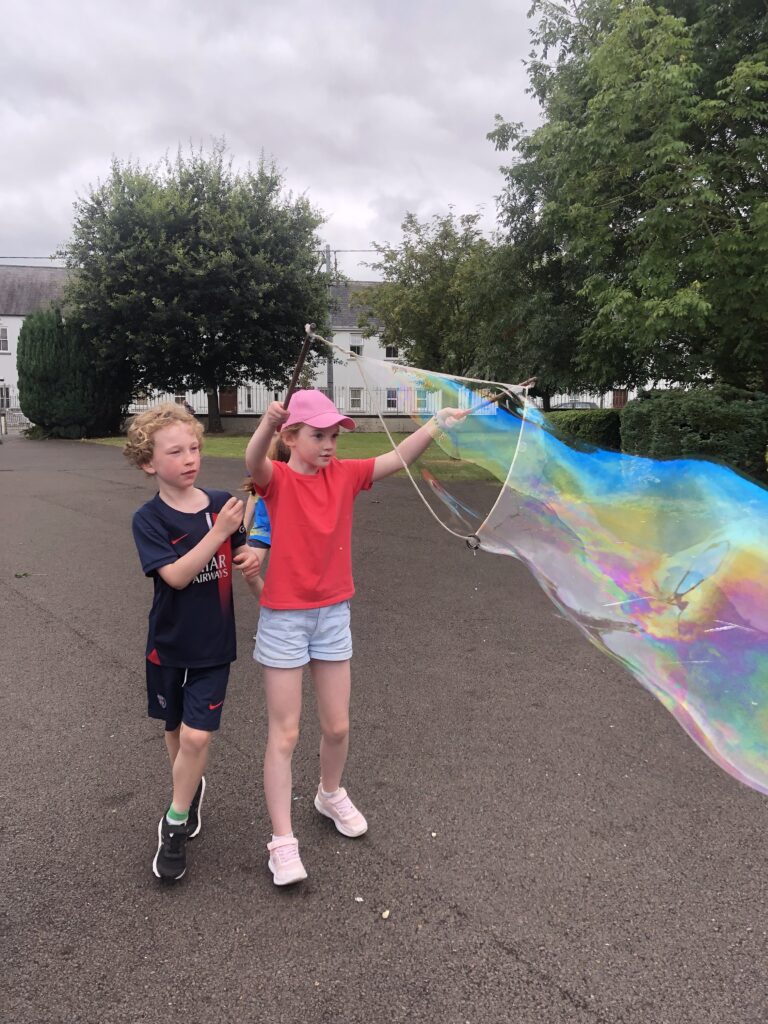
Just like regular tag, but with a twist. The person who’s "it" must tag another player’s shadow with their foot. It adds a funny challenge as shadows stretch and shift throughout the day. It’s a non-contact, silly, and super active way to keep kids moving without even noticing.
Top Tip: Try playing during late afternoon when shadows are longer and easier to catch!
Give your child a list of items to search for outside, like something round, something colourful, a stick shaped like a Y, or something that smells nice. You could even have your child put their art skills to the test and design their own checklist to tick off throughout the scavenger hunt. This fun activity encourages walking, bending, climbing, exploring, and builds strong observation skills.
Top Tip: Use a camera or phone for a photo scavenger hunt version
Set a start and finish line. Each race must be completed moving like a chosen animal - think bunny hops, crab walks, or frog jumps. This is a great way to work different muscle groups and children always love getting creative with their own animal moves.
Top Tip: As well as racing, you could also turn this into a fun guessing game where you have to guess what animal everyone is.
This absolute classic is bound to get everyone up and moving! Play some music and let everyone dance around. When the music stops, they freeze and can’t move until the music starts again. If you’re only playing with a small group, instead of knocking people out, you can have them do forfeits instead like do 10 star jumps or hold a 15 second plank. You can also do lots of different versions of this game like musical chairs or musical bums to change things up!
Top Tip: Have kids create their own playlist with their favourite songs to keep them engaged.
Set up targets on the ground using buckets or drawing chalk circles. Kids throw beanbags, rolled up socks or small balls to try and hit the target. This game helps build aim, hand-eye coordination and concentration.
Top Tip: Turn it into a family tournament by setting up different “levels” of difficulty and moving the targets farther away. You could even get kids to compete against adults for bonus points!
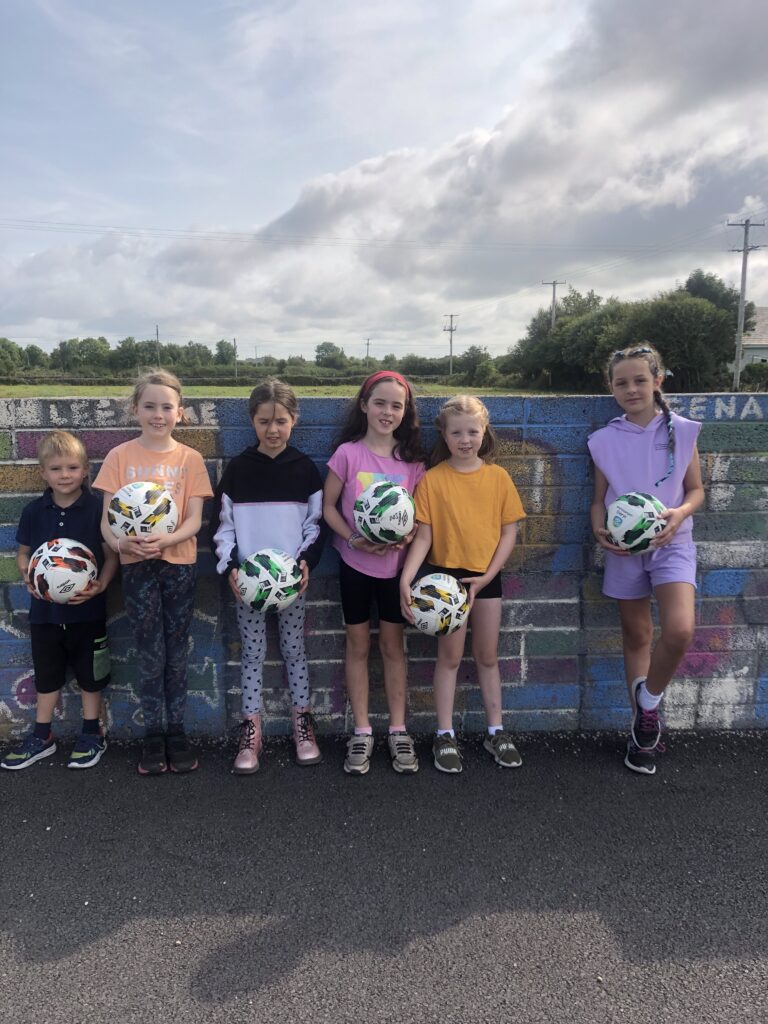
Create a short course and find something to use as your baton like a small toy or a stick. Kids can race each other or the clock by running, skipping, or hopping their way through the course. This is great for not only helping build up endurance, but it also help kids understand team play and learn self-motivation.
Top Tip: Add silly challenges between stations, like singing a song or balancing a book on your head.
When school ends, so does a lot of children’s built in movement. That means it’s up to parents and caregivers to create new ways for children to be active every day.
Regular movement improves:
And best of all? When movement is fun, kids don’t even realise they’re exercising. Whether it’s a five minute game in the morning or a full afternoon of relay races, every bit of activity counts toward that all important 60 minutes.
The long summer stretch is a perfect opportunity to help children build lifelong movement habits. With these six easy, outdoor games, you can make physical activity simple, screen free and full of fun. They don’t require expensive equipment or fancy plans, just a little time, a safe space and a willingness to play.
Want even more ways to get your kids moving? Check out our YouTube channel for free, at home activity videos created by our expert coaches, or book into one of our Summer Camps for a week packed with fun, fitness, and friendships.
For many children, sports day is a highlight of the school year; a chance to move, play, and cheer each other on in the fresh air. But traditional races like sack races, egg and spoon races and three-legged races can start to feel a bit tired, and not every child thrives in that format. So how do we keep sports day inclusive, exciting, and packed with purpose?
At School Fitness Ireland, we believe in rethinking how we do physical activity. Sports day doesn’t have to be a rigid schedule of who’s fastest or strongest. It can be creative, team-based, and designed so everyone feels part of the action.
In this post, we’re sharing five fresh sports day ideas for primary schools that go beyond the basics, with games and challenges designed to spark engagement, promote teamwork, and develop physical literacy in fun and accessible ways.
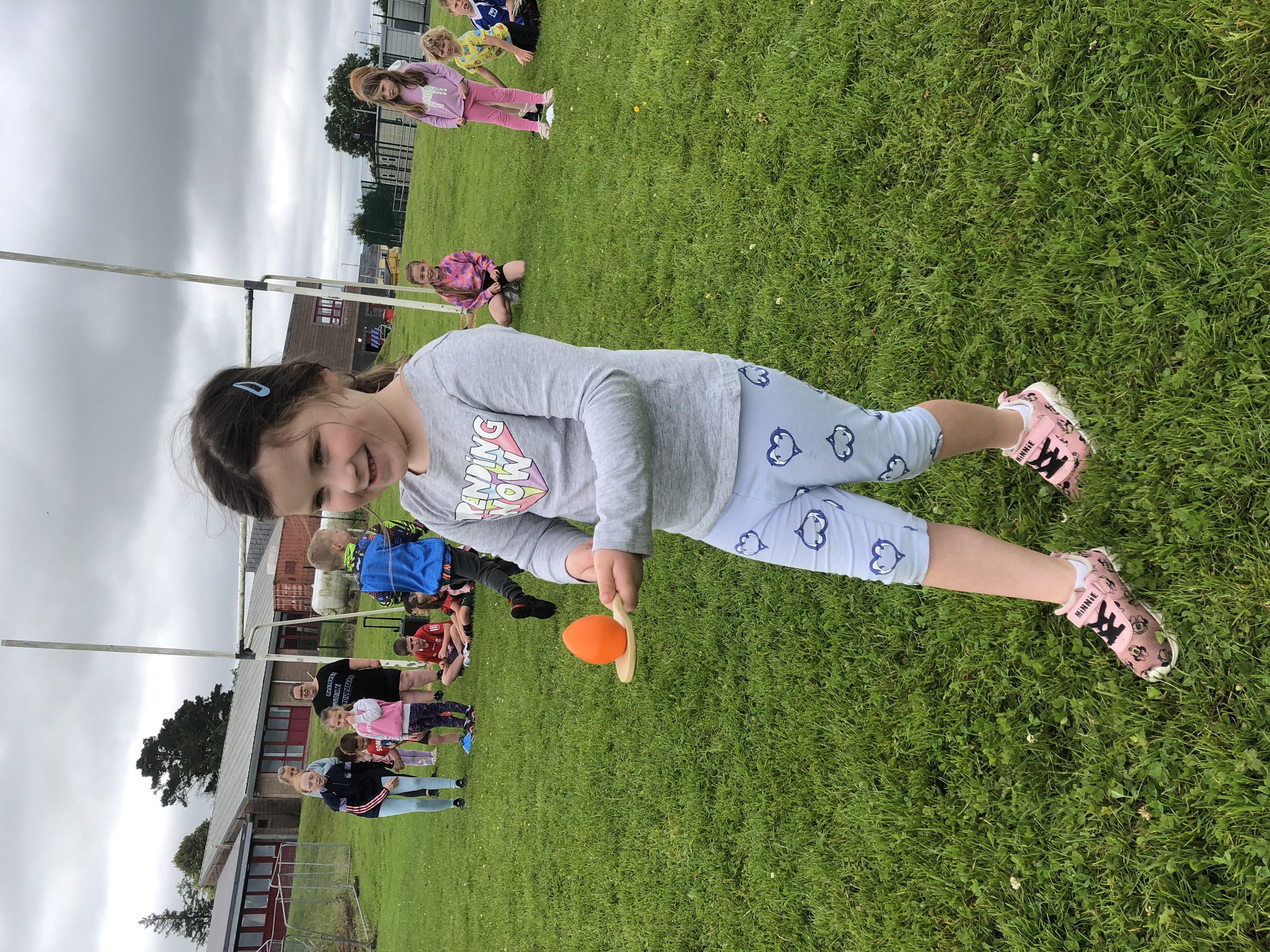
Before we dive into the activity ideas, let’s pause for a moment on why sports day is more than just a fun event.
According to the World Health Organisation, children aged 5–17 should engage in at least 60 minutes of moderate-to-vigorous physical activity daily to support healthy growth and development.1 (Check out our post on the Physical Activity Guidelines for children here!). While regular PE plays a key role in this, sports day offers a unique, high energy opportunity to meet these guidelines in a way that feels like play, not work.
Sports Days also support:
Ultimate frisbee is a non-contact team sport where players pass a frisbee downfield to teammates, aiming to catch it in the opposing team’s end zone to score a point. Players cannot run while holding the disc; they must stop and pass it. If the disc is dropped, intercepted, or goes out of bounds, possession switches to the other team. The game encourages constant movement, teamwork and fair play.
In a standard game of ultimate frisbee, each team typically has 7 players on the field. For school settings or smaller spaces, 5-a-side or smaller teams work well.
Why it works: It’s fast paced, easy to learn, and great for building teamwork. Since players can't move while holding the disc, it encourages passing and communication rather than solo efforts.
Adapt it for primary students: Reduce the pitch size and allow a few extra steps for younger players. If players are struggling with the frisbee, use a soft ball until they get used to the rules!
Bonus learning: Ultimate frisbee is self-refereed at competitive levels, teaching fairness, honesty, and respectful communication in a fun, low pressure environment.
Who says races have to be straight lines and finish flags? An obstacle course adds variety, fun, and a dose of problem solving into the mix.
Set up a series of challenges that students must complete in sequence. For example:
Run it as a timed relay, a class-vs-class challenge, or a continuous course.
Why it works: Obstacle courses are highly adaptable and keep all children engaged, whether they’re fast runners or careful climbers. They challenge multiple movement skills (balance, coordination, agility) and encourage creative thinking.
Top tip: Add silly elements like a hat they must wear or a beanbag to carry on their head for extra fun and laughter! Alternatively, you could have classes design their own obstacle courses.
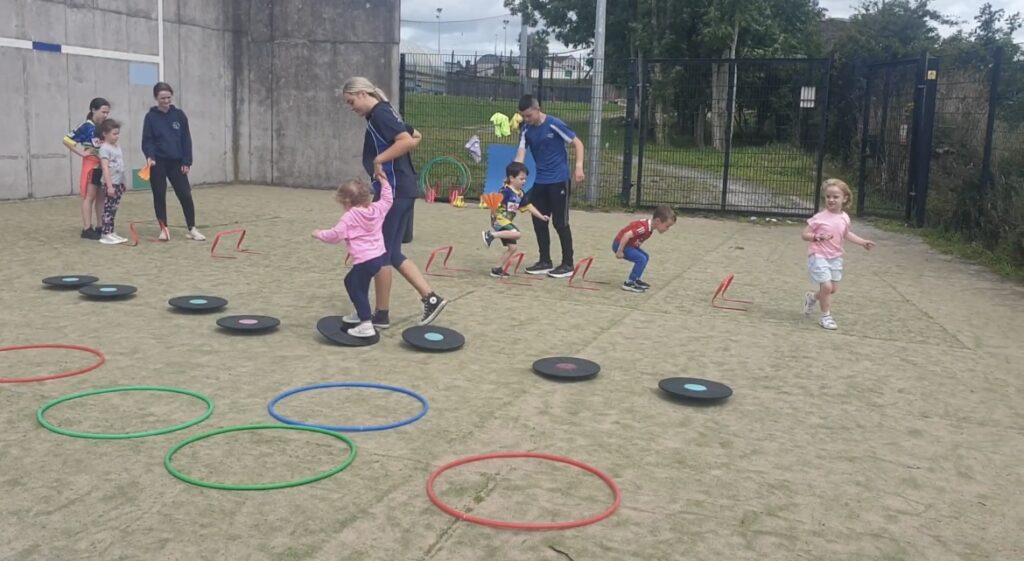
Capture the Flag is a fast-paced team game that combines movement, strategy, and excitement, and it's a brilliant way to wrap up sports day.
How it works:
To keep it low contact and inclusive:
Why it works: It’s thrilling, strategic, and promotes teamwork, decision-making, and spatial awareness. Every child has a role to play, whether they’re defending, sneaking, or rescuing teammates.
Top tip: Play multiple short rounds with team rotations to keep the pace high and ensure everyone gets a turn in different roles.
Transform your sports day into a themed adventure with physical activity challenges built around a story. For example:
Why it works: It engages imagination alongside movement, making it especially appealing to younger children or those who might not enjoy traditional sports.
Top tip: Encourage classes to dress in theme or make their own team mascots or badges.
Bonus: Pair students in buddy groups to build friendships and confidence.
Not every child thrives on races or competitive games, and that’s where these team-based challenges shine. These stations focus on teamwork, problem solving, and inclusive fun.
Set up a circuit of tasks where small groups rotate through challenges like:
Why it works: Team stations give every child the chance to contribute, no matter their athletic ability. They encourage collaboration, leadership, and creativity in a relaxed, joyful setting.
Top tip: Rotate teams every 5–8 minutes and keep instructions simple. Give teams fun names or scorecards for extra motivation, or just focus on the fun!

By moving away from traditional, individual-focused races and towards more engaging, varied activities, we create a sports day that celebrates all children, not just the fastest and strongest.
Whether it’s through an imaginative fitness challenge or a strategic frisbee game, these activities promote:
At School Fitness Ireland, we deliver high energy, age appropriate multi-activity days in schools across the country, making sports day easy, exciting and memorable.
Our expert coaches can lead sessions in:
All activities are tailored to your school's space, needs, and age groups, and designed to keep children active, engaged, and smiling.
Contact us today to book your end of term multi-activity day and let’s make sports day the best day of the year!
Active School Week is here, and what better time to get your class up and moving? We all know how important it is to get kids active throughout the day, but let’s be honest, between busy schedules, packed lessons and rainy weather, it’s not always easy to make time for it. That’s where movement breaks come in!
Movement breaks (also known as “energisers” or classroom brain breaks) are short bursts of physical activity that you can squeeze into the school day without needing any equipment or even leaving the classroom. They’re quick, they’re fun, and most importantly, they work. These little activity breaks help improve concentration, boost mood, and cut down on long periods of sitting, which studies show take up about 50–70% of a typical school day.
Before we jump into the fun stuff, it’s worth remembering why all this movement matters. The current physical activity guidelines for children and young people recommend that kids get an average of at least 60 minutes of moderate to vigorous activity every day throughout the week. That can sound like a lot at first, but it adds up quickly with things like PE, active play, sports, and yes, classroom movement breaks!
These guidelines also highlight the importance of breaking up long periods of sitting. So those little bursts of activity sprinkled throughout the school day aren’t just fun, they’re actually super important for kids’ health and focus. (Want to learn more about the guidelines? We’ve broken it down in a handy blog post. Check it out here.)
So whether you're already planning fun events for Active School Week or just want to sneak in a little more classroom based physical activity during lessons, here are 10 of our favourite teacher-approved, classroom-friendly ideas to help your students stretch, shake and smile their way through the day.
Everyone loves a bit of bingo, and this version adds a fun fitness twist! Each child gets their own bingo card filled with different exercises like 10 jumping jacks, 5 squats, or toe touches. Call out an exercise at random and when students hear one that’s on their card, they have to stand up, do the move, and mark it off. First one to complete a row shouts “Bingo!” and wins.
It’s a great way to mix movement with memory and a bit of friendly competition. Perfect for Active School Week!
Top tip: You can download our ready made fitness bingo cards here to save time!
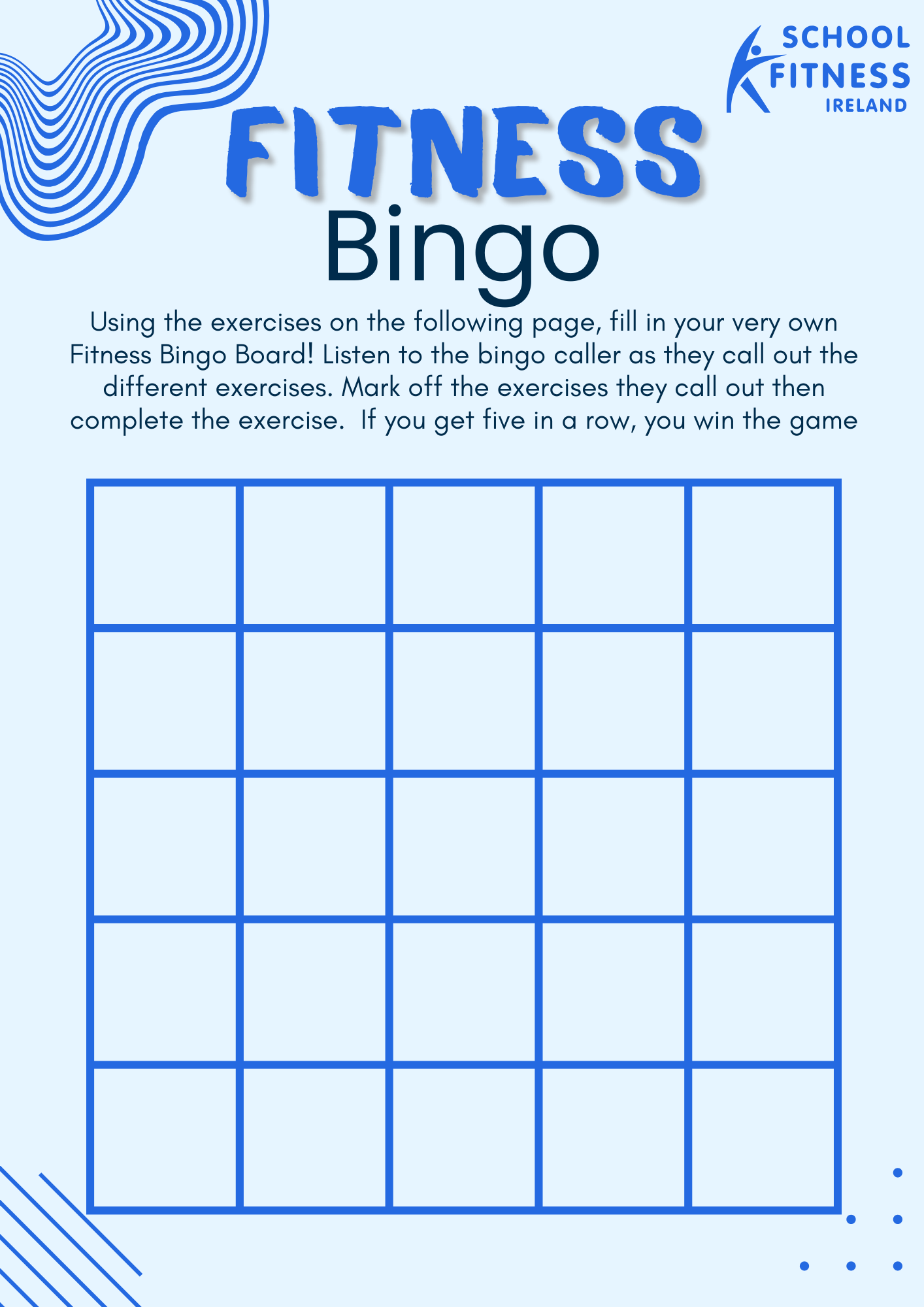
This one is a fun twist on the classic memory game, perfect for a small group or a full class circle. Start by saying, “I packed my bag and did 5 jumping jacks.” The next person repeats that and adds a new movement: “I packed my bag and did 5 jumping jacks and 1 squat.” And so on.
Not only does this game get everyone moving, but it also works on memory and listening skills. Plus, it can get pretty silly, which is always a win in our book!
An easy classroom energiser and total energy booster. Start by shaking each arm and leg eight times, then four times, then two, then one. Get faster and sillier with each round. It’s fast, it’s fun, and it gets everyone laughing while waking up tired muscles.
This one is great for lesson transitions or when the class is losing focus.
This one is as fun as it sounds. Call out different animals and have students move like them. Hop like a frog, stretch like a cat, crawl like a bear, or scuttle like a crab. You can keep each movement going for 30 seconds before switching to the next one. They can perform these movements on the spot at their desk, or if there’s space they can carefully move around the classroom!
It’s creative, playful, and helps kids use a whole range of muscles. A great addition to your Active School Week movement ideas.
Pair students up and have one lead while the other mirrors their movements. They can do slow stretches, silly dances, or energetic moves like jumping or lunges. After 30 seconds, switch roles.
This builds concentration, teamwork, and body awareness. Plus, it's a great way for quieter students to take the lead.
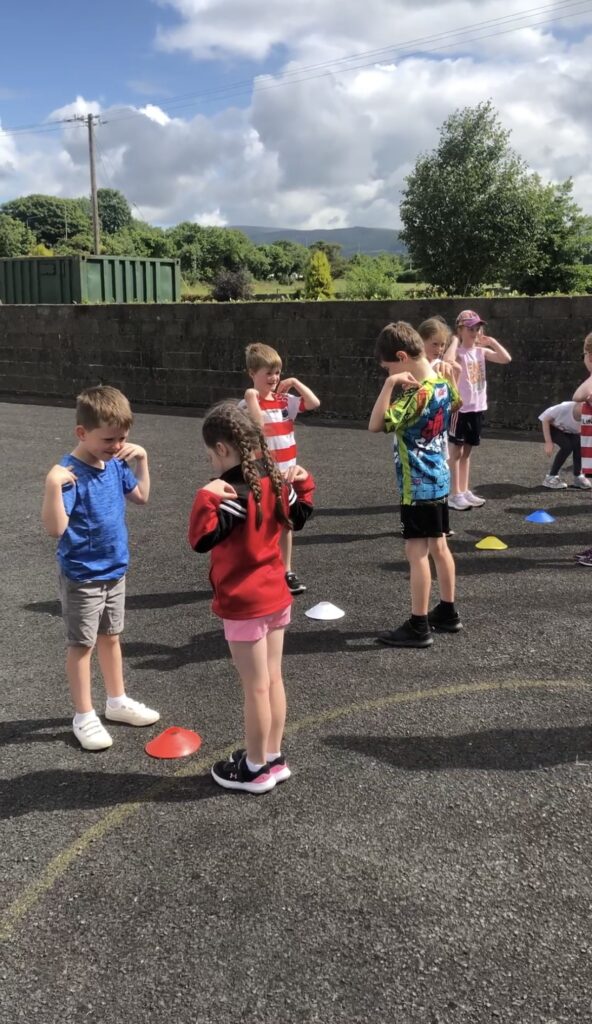
A simple and effective way to add fun and physical activity to the classroom. Play some music and let kids move around, dance, or even march in place. When the music stops, they freeze! You can add a theme to the freeze too: “freeze like a superhero,” “freeze like a ballerina,” or even “freeze like a robot”.
Ideal for transitions or brain breaks between lessons.
This gentle classroom movement break is perfect for a slower paced moment in the day. Have students stretch their arms up and reach from side to side, like they’re painting a rainbow in the sky. Big arcs, deep breaths, hold and stretch.
This one doubles as a calming strategy while still getting bodies moving. A great post-lunch or pre-home time activity.
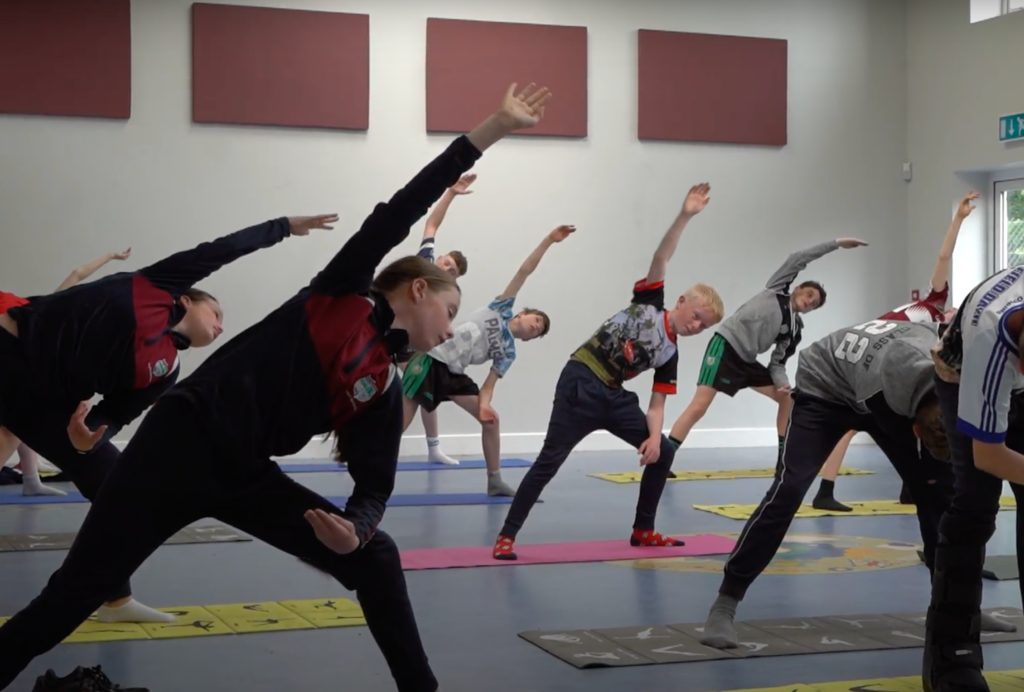
Call out different colours with matching actions:
You can mix it up and speed up the colour changes for added challenge! This one gets hearts pumping and minds focused, making it a great brain break to refocus students.
Call out emotions and let the class act them out using movement. For example:
This is a fun way to explore emotional expression while getting in some sneaky physical activity. Great for SPHE lessons or when your class needs to let off a little steam.
Assign an exercise to each number on a dice. For example:
Roll the dice and the whole class does the activity together. Want to make it more interactive? Let students roll the dice themselves!
Getting active during school hours doesn’t have to mean huge changes or big time commitments. Movement breaks are a quick and easy way to bring more physical activity into your classroom and they don’t require equipment, prep, or even leaving the room.
During Active School Week, it’s the perfect time to try out a few of these teacher approved classroom movement ideas and see what works best for your class. Who knows, your students might even ask for them again and again!
Want to get involved? Tag us in your Active School Week fun and show us your favourite classroom energisers in action. Happy moving!
Looking for even more ways to keep your class moving during Active School Week and beyond? We're uploading a new activity video everyday on our YouTube channel! Each one is quick, fun and designed for kids to follow right at their desks, no equipment or extra space needed. It's a great way to add a little extra movement to your day without any extra prep. Click here to check out our YouTube channel and follow along.
By Sam Wheeldon
It’s no secret that kids today are moving less than they used to, something that’s causing real concern when it comes to their overall motor development (Coach Laura dives into this in her latest article!). According to the Active Start guidelines from the National Association for Sport and Physical Education (NASPE), helping young children develop movement skills should be a key focus in early education (Goodway et al., 2009).
Fundamental Movement Skills (FMS) are the building blocks for confident, capable, and motivated movers. But the reality is, many kids in primary school right through to secondary school, aren’t mastering these skills as they should. Without a solid foundation in movement, it’s harder for them to pick up more complex skills, enjoy sports, and even develop socially and cognitively (V. Gregory Payne & Isaacs, 1987). Simply put, if we want kids to stay active for life, we need to make sure they’re getting the right start!
Kids naturally develop their FMS by playing different sports and being active. In fact, many experts, including sports leaders and paediatricians recommend that children try multiple sports until at least early adolescence rather than specialising too soon. This helps them build skills across all three key FMS categories.
But in Ireland, there’s a strong focus on sports that involve object control skills, especially for kids. The Children’s Sport Participation and Physical Activity (CSPPA) study in 2022 found that four out of the five most popular sports for primary school boys were ball sports. Girls took part in a slightly wider variety of activities, but overall, there’s still a big emphasis on ball games (CSPPA Report, 2022). (Check out Tables 1.1 & 1.2 below for the breakdown!).
| Boys’ Sports Participation Rates | |||
| Primary | Secondary | ||
| Sport | % | Sport | % |
| Soccer | 56 | Soccer | 41 |
| Gaelic Football | 47 | Gaelic Football | 38 |
| Hurling | 37 | Hurling | 26 |
| Swimming | 36 | Swimming | 26 |
| Rugby | 25 | Weight Training | 25 |
| Girls’ Sports Participation Rates | |||
| Primary | Secondary | ||
| Sport | % | Sport | % |
| Swimming | 45 | Swimming | 34 |
| Gaelic Football | 43 | Gaelic Football | 33 |
| Camogie | 40 | Dance | 25 |
| Dance | 32 | Camogie | 22 |
| Athletics | 29 | Cycling | 20 |
While ball sports help kids develop important motor skills, they don’t cover all the FMS kids need. Even children who excel in one area of movement may still struggle with others. Plus, not every child is drawn to mainstream sports, so it’s important to offer alternative ways for them to build these essential skills while having fun.
One often-overlooked activity with incredible benefits for both physical and mental development is martial arts. A review of multiple studies found that martial arts training improves cardiorespiratory fitness, speed, agility, strength, flexibility, coordination, and balance in children (Stamenković et al., 2022). One study even showed that five year olds who practiced karate for a year had twice the physical fitness growth rate compared to those in regular PE classes (Pavlova, Bodnar & Vitos, 2018). Martial arts training introduces a well-rounded mix of movement patterns, including locomotion, balance, and even object control. And for kids already involved in other sports, it can be a great supplemental activity thanks to its high potential for skill transfer, meaning the skills learned in martial arts can carry over to other sports. For example, a basketball player who develops explosive jumping power for dunking might find high jump in athletics comes naturally. Or a wrestler skilled in takedowns could have an instinctive understanding of rugby tackling without much extra training. With its diverse techniques and movement patterns, martial arts offer a wide range of skills that can benefit athletes across different sports.
One martial art in particular (taught by several School Fitness Ireland coaches!) stands out for its exceptional potential to enhance overall movement skills: Karate. With its mix of dynamic footwork, coordination, strength, and discipline, karate not only helps kids master FMS but also builds a foundation that can support success in a variety of other sports.
Karate isn’t just about kicks and punches; it’s an incredibly well rounded activity that strengthens balance, coordination, flexibility, and overall physical literacy. Plus, the skills learned in karate transfer to other sports, making it a great foundation for young athletes. Whether it’s improving agility for football, explosiveness for sprinting, or focus for academics, karate has something for everyone. Let’s break down how karate training builds physical skills that carry over into other sports and activities.
Karate training starts from the ground up, and stances are key. Holding deep, controlled positions strengthens the legs, improves balance, and enhances stability; fundamental for many sports.
Take Zenkutsu-dachi (forward leaning stance). This position increases ankle flexibility (dorsiflexion), which research links to improved vertical jump performance, a huge plus for basketball and volleyball players (Panoutsakopoulos & Bassa, 2023). Strong, stable ankles also help prevent injuries, something crucial for high-impact sports.
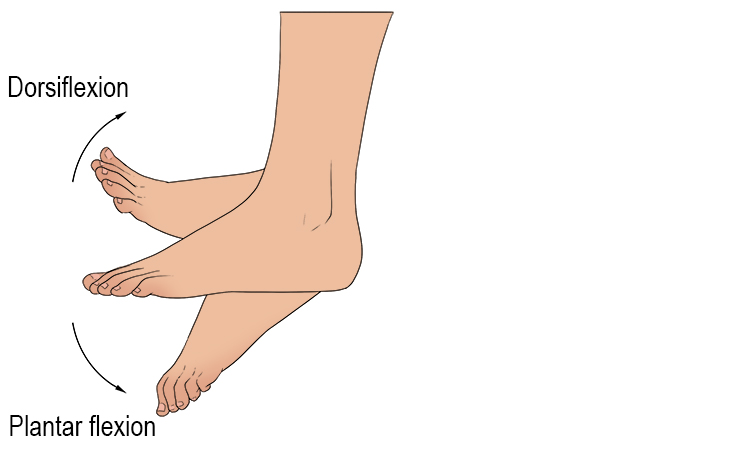
Karate kicks develop dynamic flexibility, explosive strength and coordination, all essential for different sports.
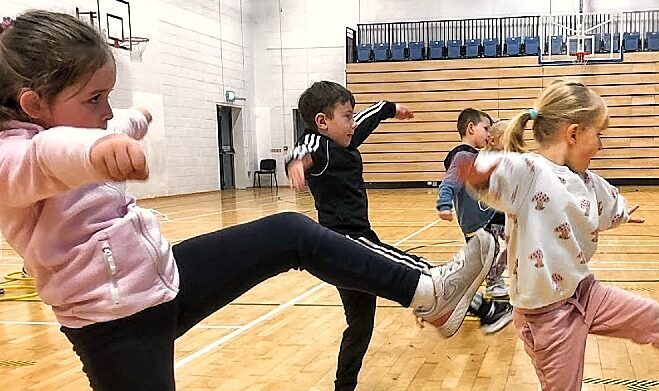
Karate includes two main types of training:
The movement involved in Kumite training builds agility, rhythm, and reaction time which are critical for sports like dance and football. It also mirrors the quick lateral movements needed by soccer goalkeepers and table tennis players, who must stay on their toes and react instantly to the ball.
While karate isn’t primarily a grappling martial art like Judo or Jiu-Jitsu, it still includes throws and takedowns that can be extremely beneficial for contact sports.
One example is Morote Gari, a lesser known karate throw that closely resembles the double leg takedown in wrestling. This technique mimics rugby tackles, making karate a great cross training option for players looking to improve their tackling ability and body control in Gaelic football and rugby.
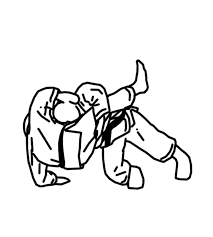
Karate isn’t just about strong punches, it’s also a great way to build upper body strength! One key technique behind this is Hikite, the act of pulling one arm back while the other strikes, blocks, or locks. This movement isn’t just for show; it generates powerful rotational force and heavily engages muscles like the lats and traps, helping to build strength and stability.

Along with classic bodyweight exercises like push-ups and sit-ups, Hikite plays a big role in karate’s ability to develop upper-body power. Plus, this pulling motion has crossover benefits for other sports, think throwing in cricket and handball, overhead serves in tennis and volleyball, and even swimming strokes like the front crawl!
Karate often incorporates training tools like tennis balls, bean bags, foam noodles, and even blunt weapons. These exercises aren’t just fun, they build hand eye coordination, proprioception, and spatial awareness. This is especially valuable for kids who may not engage in traditional ball sports but still need to develop object control skills.
Martial arts are more than just a great physical workout, they improve mental and cognitive skills that benefit both sports and academics.
Cognitive benefits include:
Kata, the set sequences of movements practiced in karate, are more than just a way to earn new belts, they’re a powerful tool for developing focus, memory, and discipline. These routines can range from 20 moves for beginners to over 50 at black belt level, requiring kids to learn, practice, and perfect them over time.
Research has shown that practicing kata can significantly improve concentration and attention in school-aged children. It’s also been linked to faster reaction times, better working memory, and even increased blood flow to the brain, all of which can support learning. Plus, studies suggest it helps reduce aggression, social difficulties, and symptoms of oppositional defiance disorder (which includes frequent anger, irritability, and arguing) (Bhattacharya, Chatterjee & Mondal, 2022; Farzaneh Parsamajd & Saeid Teymori, 2024).
Given all these benefits, it’s not surprising that kids who practice martial arts tend to score higher academically than those who don’t play sports, or even those involved in team sports (Giordano, Gómez-López & Alesi, 2021). Karate isn’t just great for physical skills, it’s a serious brain booster too!
At School Fitness Ireland, we believe there’s a sport for every child, and we’re here to help schools introduce new activities that can engage all students. Karate is a fun, non competitive way to build confidence, develop movement skills, and support physical and cognitive growth. If you’re looking for something different to bring to your school, why not give martial arts a go? Your students might just find their new favourite sport! Click here to book!
Fundamental movement skills (FMS) are the basic movements that involve the trunk, legs, arms, hands, and feet, serving as the foundation for more complex movement patterns. These skills are typically categorised into three main groups: locomotor skills, body control skills, and object control skills.
| Locomotor Skills | Body Control Skills | Object Control Skills |
| - Walking - Running - Jumping - Hopping - Skipping - Leaping - Crawling - Climbing - Dodging | - Balancing on 1 foot - Walking along a line - Rolling - Twisting - Turning - Landing - Stopping - Bending - Stretching | - Throwing - Catching - Striking - Kicking - Dribbling |
The proper development of these skills in childhood is vital for a child’s physical, cognitive, and social development. It lays the foundation for an active lifestyle and is linked to higher physical activity levels in later years. Research indicates that children should master all fundamental movement skills by the age of 8, but recent studies reveal that a significant number of Irish children have not achieved this milestone by the age of 10.
The Moving Well Being Well project (2020) assessed the proficiency of several fundamental movement skills among over 2,000 Irish primary school students. The findings showed a lack of proficiency across all components, with only 60% of students achieving mastery in balance and just over half mastering locomotor and object control skills. There were also notable gender differences, with boys excelling in object control skills like throwing and catching, while girls performed better in body control skills such as balance and skipping. These disparities are attributed to the different sports and activities typically undertaken by boys and girls, with girls more likely to engage in gymnastics and dance, and boys in sports like rugby and football.
Failure to develop these fundamental movement skills can have long-term physical and mental health implications. Children who lack confidence in their movements are less likely to engage in physical activity, potentially leading to isolation, anxiety, and low self-esteem. Therefore, it is critical to help children acquire these skills at an early age to equip them for an active lifestyle throughout their lives.
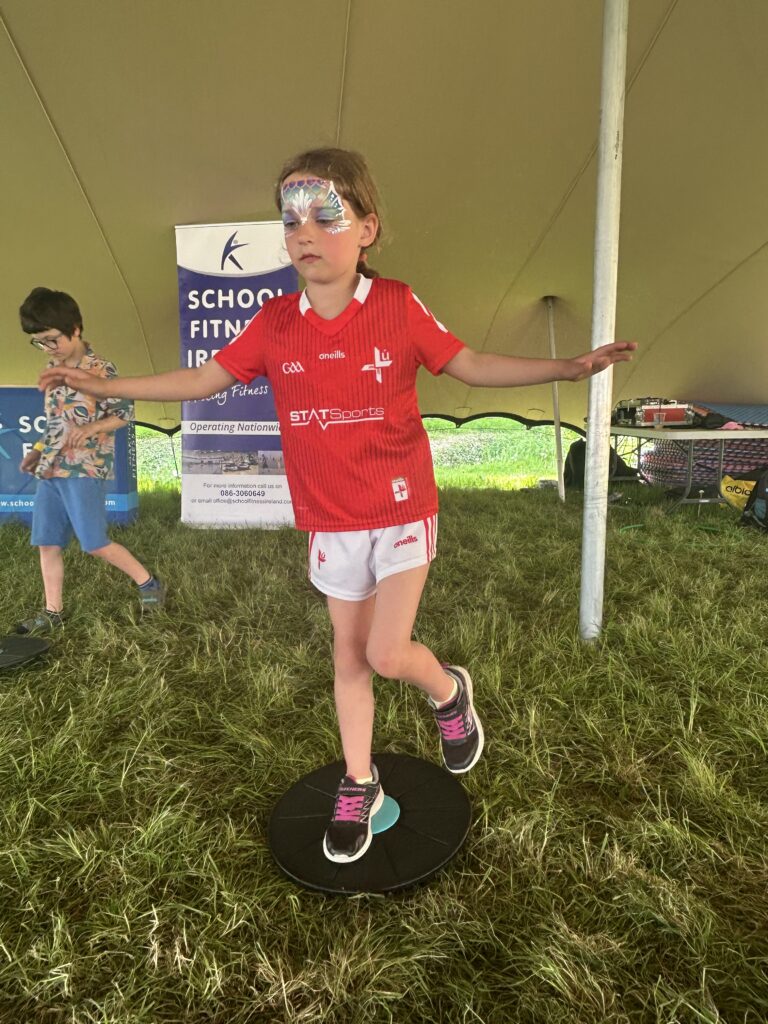
To help children master fundamental movement skills, they need ample opportunities to move their bodies. Here are some simple and engaging exercises that can be incorporated into daily activities.
| Fundamental Movement Skill | Exercise |
| Running | - Backwards and forwards - Running on the spot, focusing on arm and leg movement - Along different paths - circle, zig zags etc. - At different speeds - try fast and slow music - On different surfaces - grass, gravel, sand - Sprints - Animal runs - run like a cheetah, an elephant, a mouse - Obstacle course |
| Skipping | - Step hop practice - Skipping as tall and as small as you can - Skipping a fast and as slow as you can - How many skips does it take to get from “here” to “there” - Without touching the cracks on the ground |
| Jumping | - Forwards, backwards and side to side - Frog jumps - Lily pad jumps - Continuous standing broad jumps - Jump with overhead clap - Hurdle jumps - Jumps from a safe height e.g a bench, the bottom step - Hopscotch - Jumping in puddles |
| Balancing | - Stand on one leg (left and right) - Walk along balance beam/ narrow line - Walk with a beanbag on top of their head - Standing on one leg, pick something up off the floor - Balancing with movement - squats, toe raises, side leg lifts etc. - Balance on one leg with eyes closed - Partner balance - create shapes while holding hands with your partner |
| Rolling | - Egg rolls - hold knees to chest and tuck chin to chest and start rolling backwards and forwards or side to side - Pencil rolls - moving sideways and on the spot - Forward rolls |
| Throwing | - Roll a ball along the floor, run ahead and pick it up - Hold a ball in 2 hands, drop it and catch it with 2 hands - Underhand toss to a partner or bucket - Overhand throw to a partner or bucket - Throwing for distance - Throwing for accuracy |
| Catching | - Self toss and catch - with both hands then one hand - Partner toss and catch - on the spot and while walking/running - Bounce a catch - Balloon catch - Catch different size balls |

By focusing on the development of fundamental movement skills, parents and educators can help children build a strong foundation for physical activity, ensuring they lead healthier, more active lives.
Physical activity is defined as any bodily movement that occurs due to the contraction of skeletal muscle, resulting in energy expenditure (CDC. 2019). Regular physical activity is extremely beneficial for both physical and mental wellbeing. It helps to reduce the likelihood of, and manage noncommunicable diseases such as heart disease, diabetes and some forms of cancer; reduces symptoms of depression, anxiety and stress; and enhances cognitive abilities (WHO, 2020).

In order to ensure that people are physically active enough to avail of the benefits mentioned above, the World Health Organisation has developed recommended guidelines to follow. The Irish Department of Health also follows these same guidelines.
So what are the current recommended physical activity guidelines for children and teenagers? These differ depending on the child’s age. The World Health Organisation recommends the following:
| Age | Recommendations |
| Infants (less than 1 year) | - Be physically active several times throughout the day with floor-based play/ tummy time - Not be restrained (pram, high chair, baby carrier) for more than 1 hour at a time - Try to keep them engaged during sedentary time with reading/ storytelling |
| 1-2 year olds | - Spend 180 minutes being physically active at any intensity (spread throughout the day) - Not be restrained (pram, high chair, baby carrier) for more than 1 hour at a time - Try to keep them engaged during sedentary time with reading/ storytelling |
| 3-4 year olds | - Spend 180 minutes being physically active at any intensity, of which 60 minutes is at moderate to vigorous intensity (spread throughout the day) - Not be restrained (pram) or sitting for more than 1 hour at a time - Keep screen time to less than 1 hour, try keep them engaged during sedentary time with reading/ storytelling |
| 5-17 year olds | - Spend 60 minutes a day doing moderate to vigorous activity everyday. - Incorporate activities that will help with bone and muscle strengthening and development 3 days a week - Incorporate activities to improve flexibility - Limit sedentary time as much as possible |
From the above recommendations you can see, we are advised to be active at every point in our lives!
Despite clear evidence showing the benefits of physical activity, only 15% of children in Ireland are meeting the recommended physical activity guidelines of 60 minutes moderate to vigorous aerobic activity a day. These are the findings of the Children’s Sport Participation and Physical Activity study published in 2022. While this report did show a 2% increase in physical activity levels in children compared to data collected 5 years previous, a lot of work still needs to be done to improve this number in upcoming years.
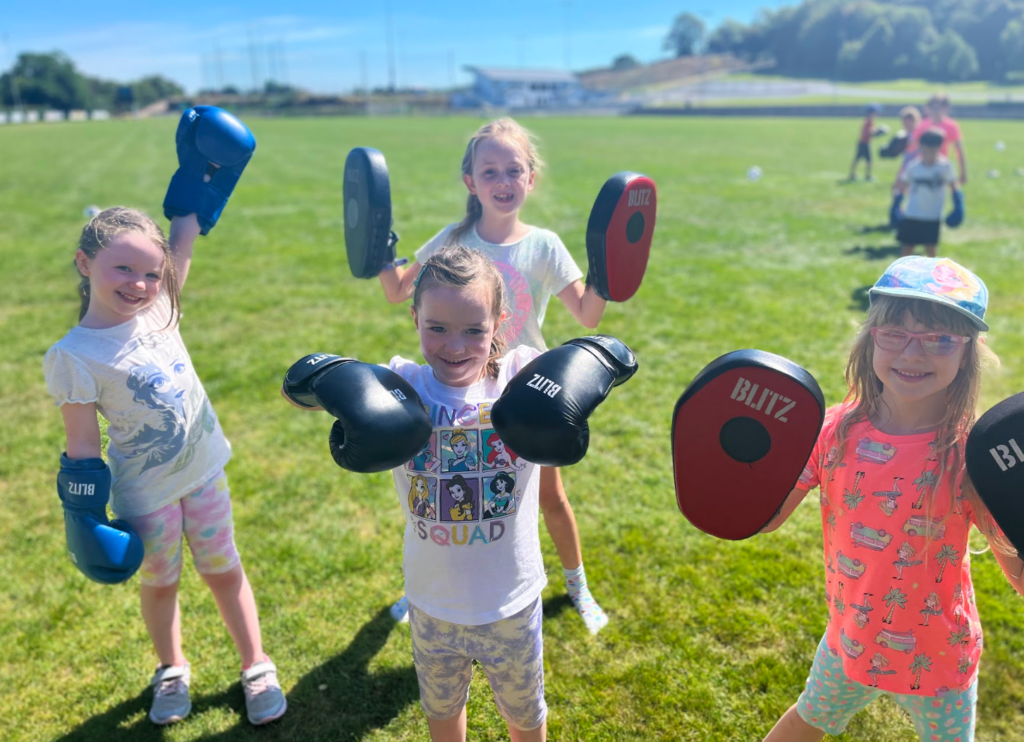
It’s important to ensure that our children and young people are as active as possible in early life, as physical activity levels during childhood are the best predictor of physical activity levels during adulthood (Telama et al., 2005).
So how can we ensure that children and young people are consistently meeting these recommended guidelines for physical activity? While the recommendations might seem quite daunting or unrealistic at first, they can be tailored to the individual’s lifestyle quite easily. While it’s recommended that children complete 60 minutes of moderate to vigorous aerobic activity a day, this just needs to be the accumulated amount, meaning it can be broken up throughout the day. For example, it might be a 10 minute walk to and from school. After school, you might bring your child to the playground or for a cycle around the park for 20 minutes. When you get home , you and your child might try out some fun dancing or active play together for 15 minutes. Then to finish off the day, you might incorporate some active breaks into their screen time e.g. during each ad break, they have to perform 10 jumping jacks. All of this gets you up to 60 minutes quite easily!
Notice how this example doesn’t include any after school activities such as football training or swimming lessons and it also doesn’t take physical activity during yard time into consideration, so there is no need to be intimidated by the 60 minute recommendation! Check out our suggestions of hitting your 60 minutes below.
Below, you will find a table that you can fill out to help ensure your child is hitting their 60 minutes of moderate to vigorous physical activity everyday! Fill in the activities you know they will definitely be doing throughout the week (walking to school, football training etc.) and the amount of time they will spend at them. This way you can easily see how much more time needs to be spent being active. You can see our example below and you can also print off your own version to fill out. You could even try to have your children design and decorate their own table to try encourage and motivate them to take accountability.
